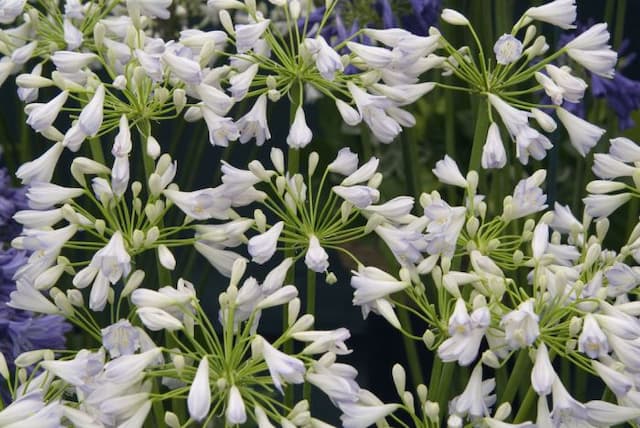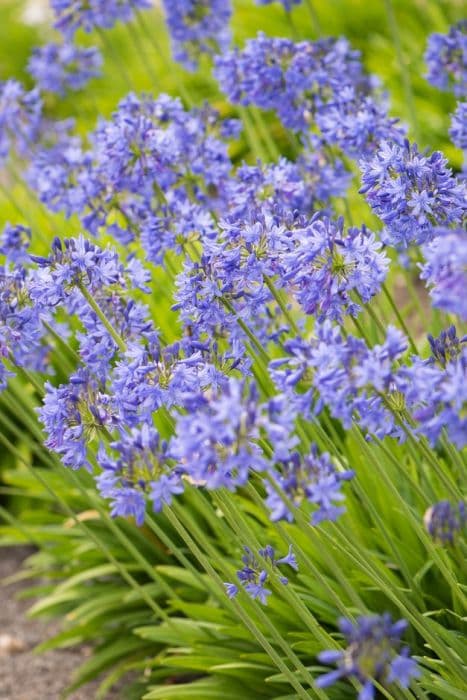African Lily Agapanthus 'Yorkshire Rose'

ABOUT
Agapanthus 'Yorkshire Rose' is a perennial plant known for its attractive flowering clusters. It features strappy, lush green foliage that forms a dense clump from which emerge sturdy, upright stems. On top of these stems sit rounded clusters of trumpet-shaped flowers. The flowers of 'Yorkshire Rose' are particularly notable for their soft pink hue, which is a bit of a rarity among agapanthus, as they more commonly come in shades of blue or white. Each bloom within the cluster has a delicate, flared appearance and can add a touch of elegance to any garden setting. The blooms are quite profuse, making it a standout during its flowering season. Overall, the plant presents a graceful and structured silhouette with its blooms held high above the foliage, creating a visual spectacle that is both eye-catching and delightful.
About this plant
 Names
NamesFamily
Amaryllidaceae.
Synonyms
African Lily, Lily-of-the-Nile.
Common names
Agapanthus 'Yorkshire Rose'.
 Toxicity
ToxicityTo humans
Agapanthus, commonly known as Lily of the Nile or African Lily, possesses certain toxic components. The plant contains substances like saponins and glycosides which can cause poisoning if ingested. Symptoms of Agapanthus poisoning in humans may include nausea, vomiting, diarrhea, and abdominal pain. In severe cases, it may also cause dizziness and tremors. Handling the plant may occasionally result in skin irritation or allergic reactions. It is important to be cautious and avoid consuming any part of the plant.
To pets
Agapanthus, or Lily of the Nile, is also toxic to pets such as dogs and cats. Like in humans, the plant's saponins and glycosides can be harmful if pets ingest any part of it. Symptoms of poisoning in pets can include vomiting, diarrhea, drooling, lethargy, and abdominal pain. In severe cases, it might lead to muscle tremors or cardiac issues. It is advisable to keep pets away from the plant to prevent any accidental ingestion.
 Characteristics
CharacteristicsLife cycle
Perennials
Foliage type
Evergreen
Color of leaves
Green
Flower color
Varies
Height
2 feet [60 cm]
Spread
2 feet [60 cm]
Plant type
Bulb
Hardiness zones
8
Native area
South Africa
Benefits
 General Benefits
General Benefits- Ornamental value: Agapanthus 'Yorkshire Rose' has attractive blooms that add beauty to gardens and landscapes.
- Drought tolerance: Once established, it can tolerate periods of low water availability, making it suitable for xeriscaping.
- Low maintenance: It requires minimal care once established, making it ideal for gardeners of all levels.
- Attracts pollinators: The flowers can attract bees, butterflies, and other pollinating insects, supporting local ecosystems.
- Long blooming season: It produces flowers for an extended period, typically in the summer, providing long-lasting visual interest.
- Versatility: Suitable for borders, pots, and as a focal point in a garden design.
- Deer resistance: It is not a preferred plant for deer, reducing the likelihood of damage in areas with deer populations.
- Perennial growth: As a perennial, it will return year after year, offering a lasting presence in the garden.
 Medical Properties
Medical PropertiesThis plant is not used for medical purposes.
 Air-purifying Qualities
Air-purifying QualitiesThis plant is not specifically known for air purifying qualities.
 Other Uses
Other Uses- Agapanthus 'Yorkshire Rose' can be used as an art subject for botanical illustration or garden photography, owing to its striking flowers and foliage.
- The sap from Agapanthus can serve as a mild adhesive in small-scale and emergency applications, similar to how natural latex might be used.
- Due to its thick roots, Agapanthus can be planted for soil erosion control on slopes or banks where other plants might not thrive.
- The tough leaves of Agapanthus can be used in weaving or plaiting to create small baskets, mats, or decorative items.
- Some artists use the stems and flower heads of Agapanthus as natural brushes or stamps to create unique patterns in their artwork.
- Agapanthus flowers are sometimes dried and used in potpourri mixtures for their color and shape rather than their scent.
- The dried seed heads of Agapanthus can be used as a natural rattling noise-maker for children's toys or in musical instruments.
- Agapanthus can act as a privacy screen when planted in clumps or hedges due to its dense foliage.
- Its striking blue flowers can be used as a natural dye for fabrics or paper, a common practice in some traditional arts.
- The flowers and buds can be incorporated into floral arrangements, adding a sculptural element to table settings and bouquets.
Interesting Facts
 Feng Shui
Feng ShuiThe Agapanthus is not used in Feng Shui practice.
 Zodiac Sign Compitability
Zodiac Sign CompitabilityThe Agapanthus is not used in astrology practice.
 Plant Symbolism
Plant Symbolism- Love Letters: Agapanthus is sometimes referred to as the "flower of love," with its name derived from the Greek words 'agape' meaning love, and 'anthos' meaning flower. The 'Yorkshire Rose' variation can especially be symbolic of romantic correspondence, suggesting the sharing of affection and emotion through written words, likened to the act of sending a rose.
- Enduring Love: With its firm and long-lasting blooms, agapanthus embodies a love that endures over time—making it a perfect gift to represent long-term relationships or marriages, and the endurance of passion and unity similar to the perennial nature of the Yorkshire Rose.
- Beauty: The elegant and attractive flowers of the Agapanthus 'Yorkshire Rose' are often associated with beauty and admiration, symbolizing the appreciation of physical and inner beauty, much like how roses are traditionally seen as a representation of such qualities.
- Fertility: The plant's lush and abundant flowering can represent fertility and the creation of life. Agapanthus's ability to multiply through its seeds and rhizomes echoes the fecundity often associated with roses, symbolizing birth and renewal.
- Freedom: With its tall and unrestrained growth, agapanthus can also symbolize a sense of freedom and openness, resonating with the expansive and wild nature of Yorkshire’s countryside where the 'rose' prospers—encouraging a free spirit and an open heart.
- Prosperity: Agapanthus, with its full and robust blooms, is often seen as an emblem of prosperity and good fortune. The 'Yorkshire Rose', in particular, might resonate with abundance and wealth, suggesting thriving in various aspects of life.
 Water
WaterFor the Lily of the Nile or Agapanthus, ensure soil moisture by watering deeply once a week, allowing the soil to dry out slightly between waterings. During the growing season, this may translate to approximately 1 gallon for outdoor plants, depending on climate and soil type. In hotter, drier conditions, you might need to water twice a week, while in cooler, wetter climates, once every ten days could suffice. Always avoid overhead watering to prevent fungal diseases, and instead water at the base of the plant. Reduce watering in winter to prevent root rot, particularly if the plant is in a colder climate.
 Light
LightThe Lily of the Nile prefers full sun to partial shade. The ideal spot for this plant is one where it receives at least six hours of sunlight per day, but it can also tolerate some afternoon shade. Avoid deep shade locations, as this will reduce blooming and can cause foliage to become leggy.
 Temperature
TemperatureThe Lily of the Nile thrives in temperatures between 50°F and 80°F, enjoying warm days and cooler nights. It can survive minimum temperatures of around 40°F but should be protected from frost, which can damage the foliage and roots. In regions where temperatures dip below this range, consider planting it in a pot that can be moved indoors or provide mulch for insulation.
 Pruning
PruningPrune the Lily of the Nile after flowering, typically late summer or early fall, to remove spent flower stalks and encourage neatness. Deadheading, or removing old flowers before they set seed, can sometimes promote a second flush of blooms. Annual pruning of old or damaged foliage in early spring helps maintain vigor and appearance. It's generally unnecessary to prune this plant more than once a year.
 Cleaning
CleaningAs needed
 Soil
SoilLily of the Nile thrives in a soil mix that is well-draining and rich in organic matter, with a pH range of 6.0 to 6.5. To create an ideal soil mix, combine two parts loam, one part peat moss, and one part perlite or coarse sand to ensure proper drainage. It's essential to maintain slight acidity, as too alkaline conditions can impair the plant's uptake of essential nutrients.
 Repotting
RepottingLily of the Nile should be repotted every 2 to 3 years to refresh the soil and provide additional space for the roots to grow. It's best to repot in the spring before the growing season starts, taking care to disturb the roots as little as possible and ensuring the new container has adequate drainage.
 Humidity & Misting
Humidity & MistingLily of the Nile prefers moderate humidity levels, ranging from 40% to 60%, which is often the typical range found in many home environments. Do not allow the humidity to drop too low as it can cause the leaf tips to brown.
 Suitable locations
Suitable locationsIndoor
Place Lily of the Nile in bright, indirect light.
Outdoor
Plant in full sun to partial shade, and shelter from strong winds.
Hardiness zone
8-10 USDA
 Life cycle
Life cycleAgapanthus 'Yorkshire Rose', commonly known as African Lily, begins its cycle with seed germination, typically in spring when the soil warms up. The young seedlings establish themselves, producing a rosette of strap-like leaves. As the plant matures, it enters a vegetative stage, developing a strong root system and more foliage. In summer, the African Lily enters the flowering stage, sending up tall stalks topped with globes of trumpet-shaped flowers, usually in shades of blue or violet. After flowering, seed pods may form, and once they dry, they release seeds, continuing the cycle. Over years, clumps of the African Lily become denser and may need division to maintain vigor and encourage flowering.
 Propogation
PropogationPropogation time
Spring-Early Summer
The most popular method of propagation for the Agapanthus 'Yorkshire Rose', commonly known as African Lily, is division. This process is best done in the spring or early fall. To propagate by division, carefully lift the plant from the ground using a garden fork, ensuring minimal damage to the roots. Gently separate the root mass into smaller sections, making sure each new section has a portion of the roots and at least one or two growing points or shoots. These sections can then be replanted in well-draining soil at the same depth they were growing previously, spaced approximately 12 to 18 inches apart (about 30 to 45 centimeters apart). Water the newly planted divisions thoroughly to help establish them. This method of propagation allows gardeners to create new plants that are genetically identical to the parent and typically grow to flowering size within a couple of years.









